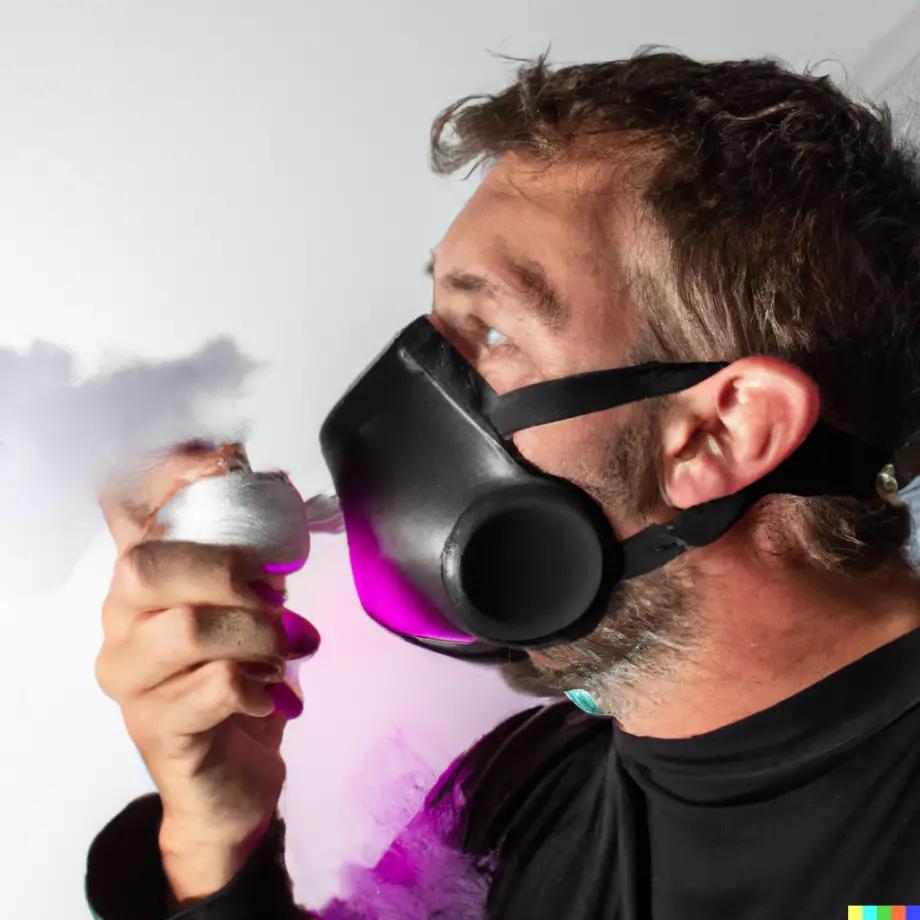For many artists and DIY enthusiasts, spray paint is a go-to tool for adding a pop of color and personality to any project.
And if you are a regular painter like me, you already know that mishaps like inhaling the spray can accidentally occur. These mishaps can result in both short and long-term consequences, which can be serious if not taken prompt action.
Although the best cure is prevention, however, if you’re already reading this article, I guess we’re past that point.
Deep breathing exercises, drinking fluids, steam inhalation, controlled coughing, eating anti-inflammatory foods, nebulizers, and other natural remedies can help to clear your lungs of spray paint. In case of severe symptoms, it is important to seek immediate medical attention.
The blog further discusses the spray paint poisoning symptoms and the detailed remedies on how to clear your lungs of spray paint.
Keep reading to explore the best ways to help you overcome symptoms and prevent future exposure.
Are Spray Paints Toxic?
The toxicity of spray paint depends on the specific ingredients and chemicals used in the formula.
Some spray paints may contain harmful chemicals such as volatile organic compounds (VOCs) and lead, which can be toxic if inhaled or absorbed through the skin.
The amount and duration of exposure also play a role in determining the level of toxicity.
Here are some factors to consider when assessing the toxicity of spray paint:
- Volatile Organic Compounds (VOCs)
VOCs are chemicals that can evaporate into the air at room temperature and can be found in aerosol spray paints as solvents or carriers. The types and amounts of VOCs in spray paint vary widely depending on the formula and brand. High levels of VOC exposure can cause various symptoms, such as headaches, dizziness, and respiratory irritation, and may lead to long-term health effects, such as organ damage and cancer.
- Lead
Some older spray paints may contain lead, a toxic heavy metal that can be harmful if ingested or inhaled. Lead exposure can cause various health effects, including developmental delays, learning difficulties, and behavioral problems.
- Other Ingredients
Some spray paints may contain other potentially harmful ingredients, such as solvents, pigments, and additives. These ingredients can cause respiratory irritation, skin irritation, and other health effects depending on the type and amount of exposure.
To learn more about the toxicity of spray paints, read our article Is Spray Paint Toxic and 5 Ways You Can Get Rid of Its Smell.
What Happens When You’ve Accidentally Inhaled Spray Paint?

Now that we already know that spray paints are toxic, inhaling spray paint can be harmful and potentially dangerous to your health. The effects of inhaling spray paint can vary depending on the amount of exposure and the type of paint used.
When you accidentally inhale spray paint, the toxic chemicals in the paint can enter your lungs and bloodstream. The fumes from the paint can irritate your eyes, nose, throat, and lungs, leading to a range of symptoms and affecting your respiratory and nervous systems.
The toxic chemicals present in the paint can:
- Enter your lungs and bloodstream.
- Irritate your eyes, nose, throat, and lungs.
- Cause symptoms such as headache, dizziness, nausea, vomiting, and shortness of breath.
- Damage your respiratory system, increasing the risk of developing respiratory problems such as asthma and bronchitis.
- Affect your nervous system, causing symptoms such as confusion, drowsiness, and loss of consciousness in severe cases.
- Long-term exposure to spray paints and certain chemicals can even cause cancer. Here are 5 Ways You Can Avoid Cancer.
What is Spray Paint Poisoning?
Spray paint poisoning is a serious health condition caused by inhaling the fumes and chemicals in spray paint. Spray paint poisoning can occur when individuals accidentally inhale large amounts of chemicals present in aerosol spray paint cans.
Since spray paint fumes are addictive, some people abuse them to get that high effect. But this can lead to a range of psychological and physical symptoms. These can range anywhere from respiratory, neurological, cardiovascular, addiction, and mental health problems. In severe cases of inhalation, spray paint poisoning can even lead to coma.
How Long Does Spray Paint Poisoning Last?
How long paint fumes stay in your system depends on the duration of spray paint poisoning. The symptoms can vary depending on the severity of exposure and the type of chemicals involved.
Here are some general guidelines for the duration of spray paint poisoning symptoms:
- Mild symptoms
If exposure to spray paint fumes is mild, symptoms such as headaches, dizziness, and nausea may last a few hours to a day or two. In most cases, these symptoms will resolve independently without medical treatment.
- Moderate symptoms
If exposure to spray paint fumes is more significant, symptoms such as difficulty breathing, chest pain, and confusion may last several days. Sometimes, medical treatment may be necessary to manage symptoms and prevent further complications.
- Severe symptoms
If exposure to spray paint fumes is severe, symptoms such as coma and respiratory failure may occur. In these cases, immediate medical attention is required, and symptoms may last several weeks or months.
How to Clear Lungs of Spray Paints
Several remedies may help clear your lungs and ease your symptoms. Here are some possible remedies:
- Fresh Air: The first step in treating spray paint exposure is to remove yourself from the area where the fumes are present and get fresh air. If possible, go outside or open windows to increase ventilation.
- Hydration: Drinking plenty of fluids, such as water or herbal tea, can help keep the lungs hydrated and promote mucus clearance. Hydration also helps with dizziness, lightheadedness, and nausea.
- Ginger and Peppermint: These are nature’s medicine to treat nausea and dizziness and can be consumed as tea, oils, or capsules.
- Breathing Exercises: Deep breathing exercises, such as pursed-lip or diaphragmatic breathing, can help improve and detoxify your body and lung function and reduce respiratory symptoms.
- Controlled Coughing: Practicing controlled coughing techniques, such as huffing or forced expiratory techniques, can help clear mucus from the lungs and improve breathing.
- Steam Inhalation: Inhaling steam from a hot shower or a bowl of hot water can loosen mucus in the lungs and relieve respiratory symptoms.
- Exercise: Regular exercise can help improve lung function and reduce respiratory symptoms. Moderate-intensity exercises like walking or cycling 30 minutes a day is a great way to introduce exercise to your routine.
- Anti-inflammatory Foods: A diet rich in anti-inflammatory foods, such as fruits, vegetables, lean protein, and whole grains can help reduce inflammation and improve symptoms.
- Ventilators: Using a ventilator or respiratory support device can help improve breathing and clear the lungs of harmful chemicals.
- Air Purifiers: An air purifier can help remove harmful chemicals and pollutants and improve indoor air quality.
- Avoid Perfumes: Strong perfumes and fragrances can irritate the lungs and exacerbate respiratory symptoms. Avoid using perfumes or scented products and opt for unscented products instead.
- Avoiding Smoking and Alcohol: Smoking and alcohol can irritate the lungs and worsen the symptoms. Avoid smoking and limit alcohol consumption to improve lung health.
It is important to note that if your symptoms are severe, these remedies might not be helpful and medical treatment may be necessary.
PS: You may need to follow multiple remedies from the above list to clear your lungs from chemicals.
7 Tips to Prevent Future Exposure
Next time you’re up for a DIY, ensure you’ve all the preventative measures handy to avoid inhalation.
Below are some tips that can help prevent future exposure:
- Make sure you use spray paint in an open and well-ventilated area to reduce the amount of fumes you inhale.
- Wear a mask or respirator to protect your lungs from the harmful fumes.
- Choose low-VOC spray paint products that are less toxic and emit fewer fumes. Acrylic paints or water-based paints are always safer than oil-based paints.
- Take frequent breaks to step outside and get fresh air.
- Keep a safe distance and avoid spraying near your face to prevent inhaling the fumes.
- Wear protective clothing such as gloves and long-sleeved shirts to minimize skin exposure to the spray paint.
- Consider using a spray booth or ventilation system to capture and exhaust fumes from spray painting.
FAQs
Is it dangerous to spray paint indoors?
Yes, it can be dangerous to spray paint indoors due to the risk of inhaling toxic fumes and the lack of proper ventilation.
What to do after inhaling spray paint fumes?
After inhaling paint fumes, move to a well-ventilated area, rest, and drink plenty of water. Seek medical attention if symptoms persist.
Can you die from inhaling spray paint?
Inhaling extremely large amounts of spray paint fumes can cause serious health issues and, in rare cases, lead to death.
How to clear your lungs from chemicals?
Some ways to clear your lungs from chemicals include staying hydrated, using a respirator mask, and getting fresh air.
Can your lungs heal from paint fumes?
The extent of lung damage caused by paint fumes depends on the level and duration of exposure. While the lungs have some ability to heal, it’s important to seek medical attention if symptoms persist.
How to free mucus from the lungs?
Ways to free mucus from the lungs include staying hydrated, using a humidifier, and practicing controlled coughing exercises to expirate mucus.
Conclusion
Spray paint fumes can harm your respiratory system, and it’s important to take necessary precautions to prevent inhalation and clear your lungs after exposure. Using low-VOC spray paints, wearing a respirator mask, and ensuring proper ventilation can minimize the risk of inhalation.
In case of exposure, seeking medical attention and implementing remedies such as deep breathing exercises, staying hydrated, and using air purifiers can help clear your spray paint lungs and prevent long-term respiratory issues. Remember to prioritize your safety and take necessary measures to protect your health while engaging in spray painting projects.
Happy Painting!


